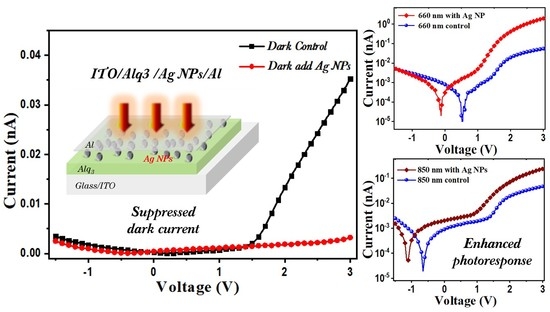Organic Photodetectors with Extended Spectral Response Range Assisted by Plasmonic Hot-Electron Injection
Abstract
:1. Introduction
2. Materials and Methods
2.1. Fabrication of Device
2.2. Characterization
3. Results and Discussion
4. Conclusions
Supplementary Materials
Author Contributions
Funding
Institutional Review Board Statement
Informed Consent Statement
Data Availability Statement
Conflicts of Interest
References
- Guo, L.; Yin, H.; Xu, M.; Zheng, Z.; Fang, X.; Chong, R.; Zhou, Y.; Xu, L.; Xu, Q.; Li, J. In situ generated plasmonic silver nanoparticle-sensitized amorphous titanium dioxide for ultrasensitive photoelectrochemical sensing of formaldehyde. ACS Sens. 2019, 4, 2724–2729. [Google Scholar] [CrossRef] [PubMed]
- Li, W.; Xu, Y.; Meng, X.; Xiao, Z.; Li, R.; Jiang, L.; Cui, L.; Zheng, M.; Liu, C.; Ding, L. Visible to near-infrared photodetection based on ternary organic heterojunctions. Adv. Funct. Mater. 2019, 29, 1808948. [Google Scholar] [CrossRef]
- Ajiki, Y.; Kan, T.; Yahiro, M.; Hamada, A.; Adachi, J.; Adachi, C.; Matsumoto, K.; Shimoyama, I. Silicon based near infrared photodetector using self-assembled organic crystalline nano-pillars. Appl. Phys. Lett. 2016, 108, 151102. [Google Scholar] [CrossRef]
- Scales, C.; Berini, P. Thin-film Schottky barrier photodetector models. IEEE J. Quantum Elect. 2010, 46, 633–643. [Google Scholar] [CrossRef]
- Li, C.; Wang, H.; Wang, F.; Li, T.; Xu, M.; Wang, H.; Wang, Z.; Zhan, X.; Hu, W.; Shen, L. Ultrafast and broadband photodetectors based on a perovskite/organic bulk heterojunction for large-dynamic-range imaging. Light Sci. Appl. 2020, 9, 31. [Google Scholar] [CrossRef] [PubMed]
- Guo, X.; He, A.; Su, Y. Recent advances of heterogeneously integrated III–V laser on Si. J. Semicond. 2019, 40, 101304. [Google Scholar] [CrossRef]
- Casalino, M.; Coppola, G.; De La Rue, R.M.; Logan, D.F. State-of-the-art all-silicon sub-bandgap photodetectors at telecom and datacom wavelengths. Laser Photonics Rev. 2016, 10, 895–921. [Google Scholar] [CrossRef]
- Velusamy, D.B.; Haque, M.A.; Parida, M.R.; Zhang, F.; Wu, T.; Mohammed, O.F.; Alshareef, H.N. 2D organic–inorganic hybrid thin films for flexible UV-visible photodetectors. Adv. Funct. Mater. 2017, 27, 1605554. [Google Scholar] [CrossRef]
- Agostinelli, T.; Campoy-Quiles, M.; Blakesley, J.; Speller, R.; Bradley, D.; Nelson, J. A polymer/fullerene based photodetector with extremely low dark current for X-ray medical imaging applications. Appl. Phys. Lett. 2008, 93, 419. [Google Scholar] [CrossRef]
- Miao, J.; Zhang, F. Recent progress on photomultiplication type organic photodetectors. Laser Photonics Rev. 2019, 13, 1800204. [Google Scholar] [CrossRef]
- Qi, J.; Qiao, W.; Zhou, X.; Yang, D.; Zhang, J.; Ma, D.; Wang, Z.Y. High-Detectivity All-Polymer Photodetectors with Spectral Response from 300 to 1100 nm. Macromol. Chem. Phys. 2016, 217, 1683–1689. [Google Scholar] [CrossRef]
- Zhao, Z.; Li, C.; Shen, L.; Zhang, X.; Zhang, F. Photomultiplication type organic photodetectors based on electron tunneling injection. Nanoscale 2020, 12, 1091–1099. [Google Scholar] [CrossRef] [PubMed]
- Gong, X.; Tong, M.; Xia, Y.; Cai, W.; Moon, J.S.; Cao, Y.; Yu, G.; Shieh, C.L.; Nilsson, B.; Heeger, A.J. High-detectivity polymer photodetectors with spectral response from 300 nm to 1450 nm. Science 2009, 325, 1665–1667. [Google Scholar] [CrossRef] [PubMed]
- Liu, J.; Wang, Y.; Wen, H.; Bao, Q.; Shen, L.; Ding, L. Organic photodetectors: Materials, structures, and challenges. Sol. RRL 2020, 4, 2000139. [Google Scholar] [CrossRef]
- Fuentes-Hernandez, C.; Chou, W.F.; Khan, T.M.; Diniz, L.; Lukens, J.; Larrain, F.A.; Rodriguez-Toro, V.A.; Kippelen, B. Large-area low-noise flexible organic photodiodes for detecting faint visible light. Science 2020, 370, 698–701. [Google Scholar] [CrossRef] [PubMed]
- Biele, M.; Montenegro Benavides, C.; Hürdler, J.; Tedde, S.F.; Brabec, C.J.; Schmidt, O. Spray-coated organic photodetectors and image sensors with silicon-like performance. Adv. Mater. Technol. 2019, 4, 1800158. [Google Scholar] [CrossRef]
- Guo, F.; Yang, B.; Yuan, Y.; Xiao, Z.; Dong, Q.; Bi, Y.; Huang, J. A nanocomposite ultraviolet photodetector based on interfacial trap-controlled charge injection. Nat. Nanotechnol. 2012, 7, 798–802. [Google Scholar] [CrossRef]
- Huang, X.; Ji, D.; Fuchs, H.; Hu, W.; Li, T. Recent progress in organic phototransistors: Semiconductor materials, device structures and optoelectronic applications. Chem. Photo. Chem. 2020, 4, 9–38. [Google Scholar]
- Wang, C.; Zhang, X.; Hu, W. Organic photodiodes and phototransistors toward infrared detection: Materials, devices, and applications. Chem. Soc. Rev. 2020, 49, 653–670. [Google Scholar] [CrossRef]
- Lim, D.-H.; Ha, J.-W.; Choi, H.; Yoon, S.C.; Lee, B.R.; Ko, S.J. Recent progress of ultra-narrow-bandgap polymer donors for NIR-absorbing organic solar cells. Nanoscale Adv. 2021, 3, 4306–4320. [Google Scholar] [CrossRef]
- Kublitski, J.; Fischer, A.; Xing, S.; Baisinger, L.; Bittrich, E.; Spoltore, D.; Benduhn, J.; Vandewal, K.; Leo, K. Enhancing sub-bandgap external quantum efficiency by photomultiplication for narrowband organic near-infrared photodetectors. Nat. Commun. 2021, 12, 4259. [Google Scholar] [CrossRef]
- Li, N.; Lim, J.; Azoulay, J.D.; Ng, T.N. Tuning the charge blocking layer to enhance photomultiplication in organic shortwave infrared photodetectors. J. Mater. Chem. C 2020, 8, 15142–15149. [Google Scholar] [CrossRef]
- Yang, Z.; Du, K.; Wang, H.; Lu, F.; Pang, Y.; Wang, J.; Gan, X.; Zhang, W.; Mei, T.; Chua, S.J. Near-infrared photodetection with plasmon-induced hot electrons using silicon nanopillar array structure. Nanotechnology 2018, 30, 075204. [Google Scholar] [CrossRef] [PubMed]
- Wang, L.; He, S.J.; Wang, K.Y.; Luo, H.-H.; Hu, J.G.; Yu, Y.Q.; Xie, C.; Wu, C.Y.; Luo, L.B. Dual-plasmonic Au/graphene/Au-enhanced ultrafast, broadband, self-driven silicon Schottky photodetector. Nanotechnology 2018, 29, 505203. [Google Scholar] [CrossRef] [PubMed]
- Hu, X.; Zou, P.; Yin, Z.; Zeng, J.; Zeng, Y.; Peng, W. Hot-electron photodetection based on graphene transparent conductive electrode. IEEE Sens. J. 2020, 20, 6354–6358. [Google Scholar] [CrossRef]
- Kunwar, S.; Pandit, S.; Kulkarni, R.; Mandavkar, R.; Lin, S.; Li, M.Y.; Lee, J. Hybrid device architecture using plasmonic nanoparticles, graphene quantum dots, and titanium dioxide for UV photodetectors. ACS Appl. Mater. Interfaces 2021, 13, 3408–3418. [Google Scholar] [CrossRef]
- Lee, C.; Choi, H.; Nedrygailov, I.I.; Lee, Y.K.; Jeong, S.; Park, J.Y. Enhancement of hot electron flow in plasmonic nanodiodes by incorporating PbS quantum dots. ACS Appl. Mater. Interfaces 2018, 10, 5081–5089. [Google Scholar] [CrossRef]
- Ouyang, W.; Teng, F.; Jiang, M.; Fang, X. ZnO film UV photodetector with enhanced performance: Heterojunction with CdMoO4 microplates and the hot electron injection effect of Au nanoparticles. Small 2017, 13, 1702177. [Google Scholar] [CrossRef]
- Zhan, Y.; Li, X.; Wu, K.; Wu, S.; Deng, J. Coaxial Ag/ZnO/Ag nanowire for highly sensitive hot-electron photodetection. Appl. Phys. Lett. 2015, 106, 081109. [Google Scholar] [CrossRef]
- Mandavkar, R.; Kulkarni, R.; Lin, S.; Pandit, S.; Burse, S.; Habib, M.A.; Pandey, P.; Kim, S.H.; Li, M.-Y.; Kunwar, S. Significantly improved photo carrier injection by the MoS2/ZnO/HNP hybrid UV photodetector architecture. Appl. Surf. Sci. 2022, 574, 151739. [Google Scholar] [CrossRef]
- Huang, X.; Li, H.; Zhang, C.; Tan, S.; Chen, Z.; Chen, L.; Lu, Z.; Wang, X.; Xiao, M. Efficient plasmon-hot electron conversion in Ag–CsPbBr3 hybrid nanocrystals. Nat. Commun. 2019, 10, 1163. [Google Scholar] [CrossRef] [PubMed] [Green Version]
- Li, J.; Cushing, S.K.; Meng, F.; Senty, T.R.; Bristow, A.D.; Wu, N. Plasmon-induced resonance energy transfer for solar energy conversion. Nat. Photonics 2015, 9, 601–607. [Google Scholar] [CrossRef]
- Wu, K.; Chen, J.; McBride, J.R.; Lian, T. Efficient hot-electron transfer by a plasmon-induced interfacial charge-transfer transition. Science 2015, 349, 632–635. [Google Scholar] [CrossRef] [PubMed]
- Hou, J.L.; Fischer, A.; Yang, S.C.; Benduhn, J.; Widmer, J.; Kasemann, D.; Vandewal, K.; Leo, K. Plasmon-Induced Sub-Bandgap Photodetection with Organic Schottky Diodes. Adv. Funct. Mater. 2016, 26, 5741–5747. [Google Scholar] [CrossRef]
- Jin, Y.; Kim, H.S.; Park, J.; Yoo, S.; Yu, K. Organic Sub-Bandgap Schottky Barrier Photodetectors with Near-Infrared Coherent Perfect Absorption. ACS Photonics 2021, 8, 2618–2625. [Google Scholar] [CrossRef]
- Luo, X.; Du, L.; Wen, Z.; Lv, W.; Zhao, F.; Jiang, X.; Peng, Y.; Sun, L.; Li, Y.; Rao, J. Remarkably enhanced red–NIR broad spectral absorption via gold nanoparticles: Applications for organic photosensitive diodes. Nanoscale 2015, 7, 14422–14433. [Google Scholar] [CrossRef]
- Luo, X.; Wen, Z.; Du, L.; Lv, W.; Zhao, F.; Tang, Y.; Chen, Z.; Peng, Y. Notably improved red photoresponse of organic diode employing gold nanoparticles plasmonic absorption. J. Nanosci. Nanotechnol. 2016, 16, 5707–5713. [Google Scholar] [CrossRef]
- Zhang, C.; Luo, Y.; Maier, S.A.; Li, X. Recent Progress and Future Opportunities for Hot Carrier Photodetectors: From Ultraviolet to Infrared Bands. Laser Photonics Rev. 2022, 16, 2100714. [Google Scholar] [CrossRef]
- Mukherjee, S.; Chowdhury, R.K.; Karmakar, D.; Wan, M.; Jacob, C.; Das, S.; Ray, S.K. Plasmon Triggered, Enhanced Light-Matter Interactions in Au-MoS2 Coupled System with Superior Photosensitivity. J. Phys. Chem. C 2021, 125, 11023–11034. [Google Scholar] [CrossRef]
- Gogurla, N.; Chowdhury, R.K.; Battacharya, S.; Datta, P.K.; Ray, S.K. Plasmon Charge transfer dynamics in Layered Au-ZnO nanocomposites. J. Appl. Phys. 2020, 127, 053105. [Google Scholar] [CrossRef]
- Mukherjee, S.; Libisch, F.; Large, N.; Neumann, O.; Brown, L.V.; Cheng, J.; Lassiter, J.B.; Carter, E.A.; Nordlander, P.; Halas, N.J. Hot Electrons Do the Impossible: Plasmon-induced Dissociation of H2 on Au. Nano Lett. 2013, 13, 240–247. [Google Scholar] [CrossRef] [PubMed]
- Chung, D.H.; Lee, J.U. Electrical Conduction Mechanism in ITO/Alq3/Al Organic Light-emitting Diodes. Trans. Electr. Electron. Mater. 2004, 5, 24–28. [Google Scholar] [CrossRef]
- Lee, I.; Lee, J.L. Transparent electrode of nanoscale metal fifilm for optoelectronic devices. J. Photonics Energy 2015, 5, 057609. [Google Scholar] [CrossRef]
- Shi, L.; Cui, Y.; Gao, Y.; Wang, W.; Zhang, Y.; Zhu, F.; Hao, Y. High Performance Ultralthin MoO3/Ag Transparent Electrode and Its Application in Semitransparent Organic Solar Cells. Nanomaterials 2018, 8, 473. [Google Scholar] [CrossRef] [PubMed]
- Schubert, S.; Hermenau, M.; Meiss, J.; Muller-Meskamp, L.; Leo, K. Oxide Sandwiched Metal Thin-Film Electrodes for Long-Term Stable Organic Solar Cells. Adv. Funct. Mater. 2012, 23, 4993–4999. [Google Scholar] [CrossRef]
- Schubert, S.; Meis, J.; Meiss, J.; Muller-Meskamp, L.; Leo, K. Improvement of transparent metal top electrodes for organic solar cell by introducing a high surface energy seed layer. Adv. Energy Mater. 2013, 3, 438–443. [Google Scholar] [CrossRef]
- Schwab, T.; Schubert, S.; Simone, H.; Frobel, M.; Fuchs, C.; Thomschke, M.; Muller-Meskamp, L.; Leo, K.; Gather, M. Highly efficient color stable inverted white top-emitting OLEDs with ultra-thin wetting layer top electrodes. Adv. Optical Mater. 2013, 1, 707–713. [Google Scholar] [CrossRef]
- Wang, W.; Cui, Y.; Fung, K.H.; Zhang, Y.; Ji, T.; Hao, Y. Comparison of Nanohole-Type and Nanopillar-Type Patterned Metallic Electrodes Incorporated in Organic Solar Cells. Nanoscale Res. Lett. 2017, 12, 538. [Google Scholar] [CrossRef]
- Wang, Z.; Hao, Y.; Wang, W.; Cui, Y.; Sun, Q.; Ji, T.; Li, Z.; Wang, H.; Zhu, F.R. Incorporating silver-SiO2 core-shell nanocubes for simultaneous broadband absorption and charge collection enhancements in organic solar cells. Synthetic Met. 2016, 220, 612–620. [Google Scholar] [CrossRef]

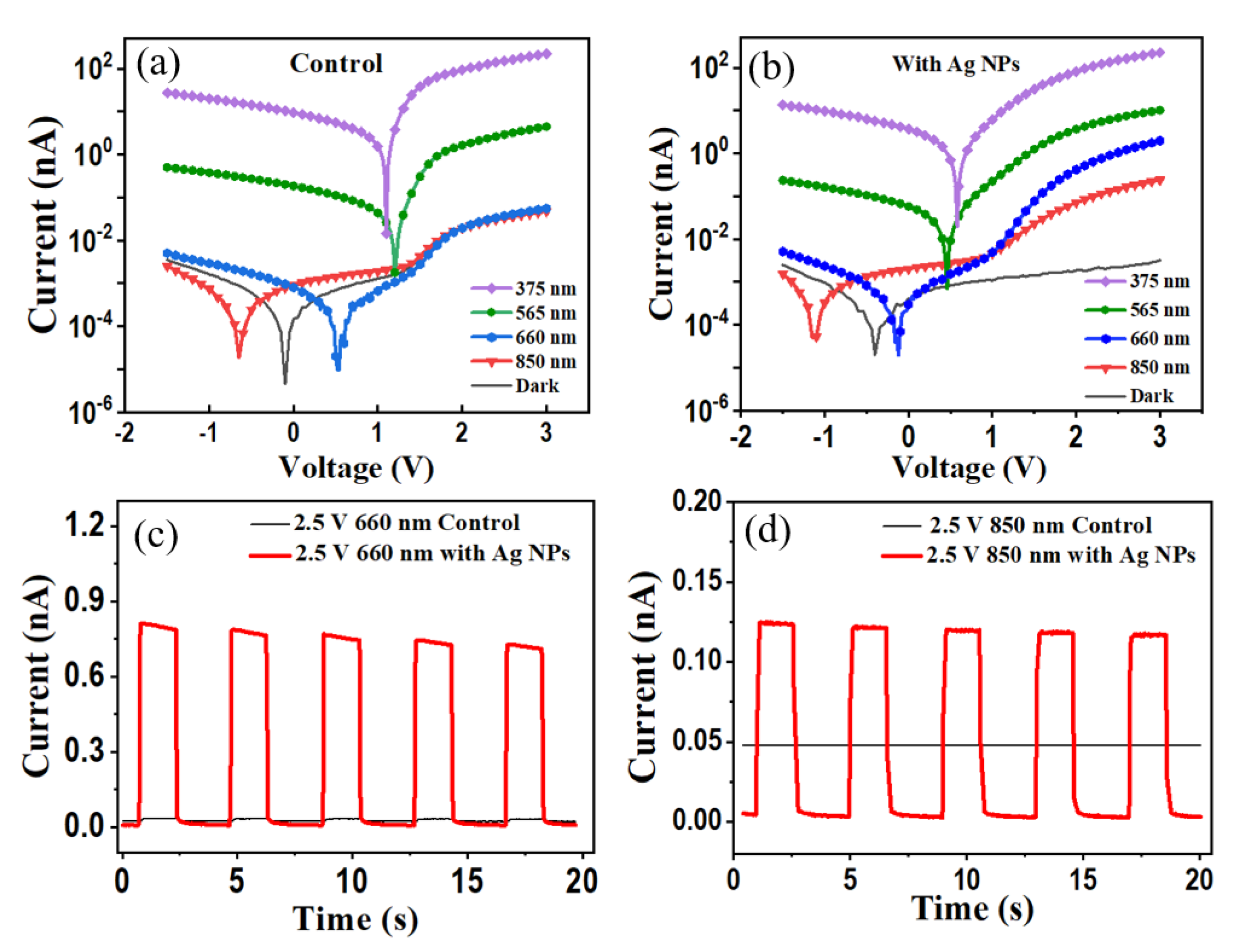
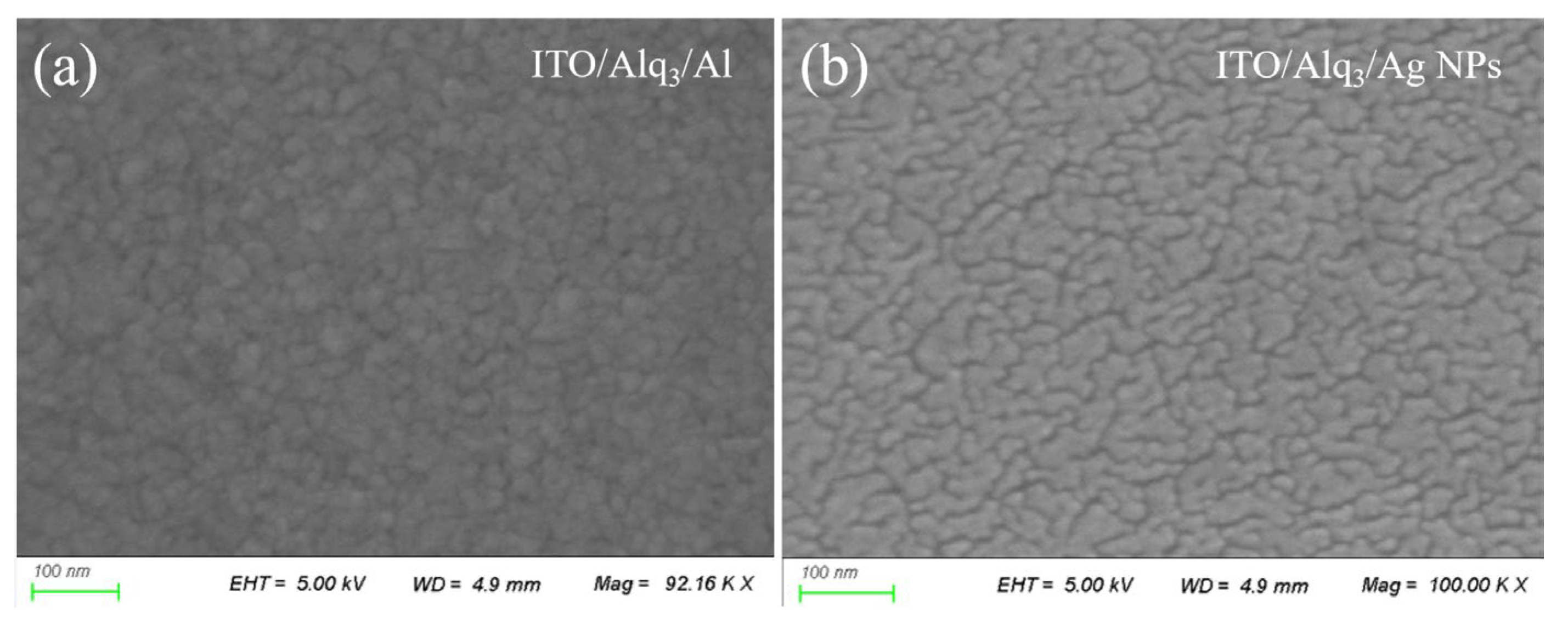
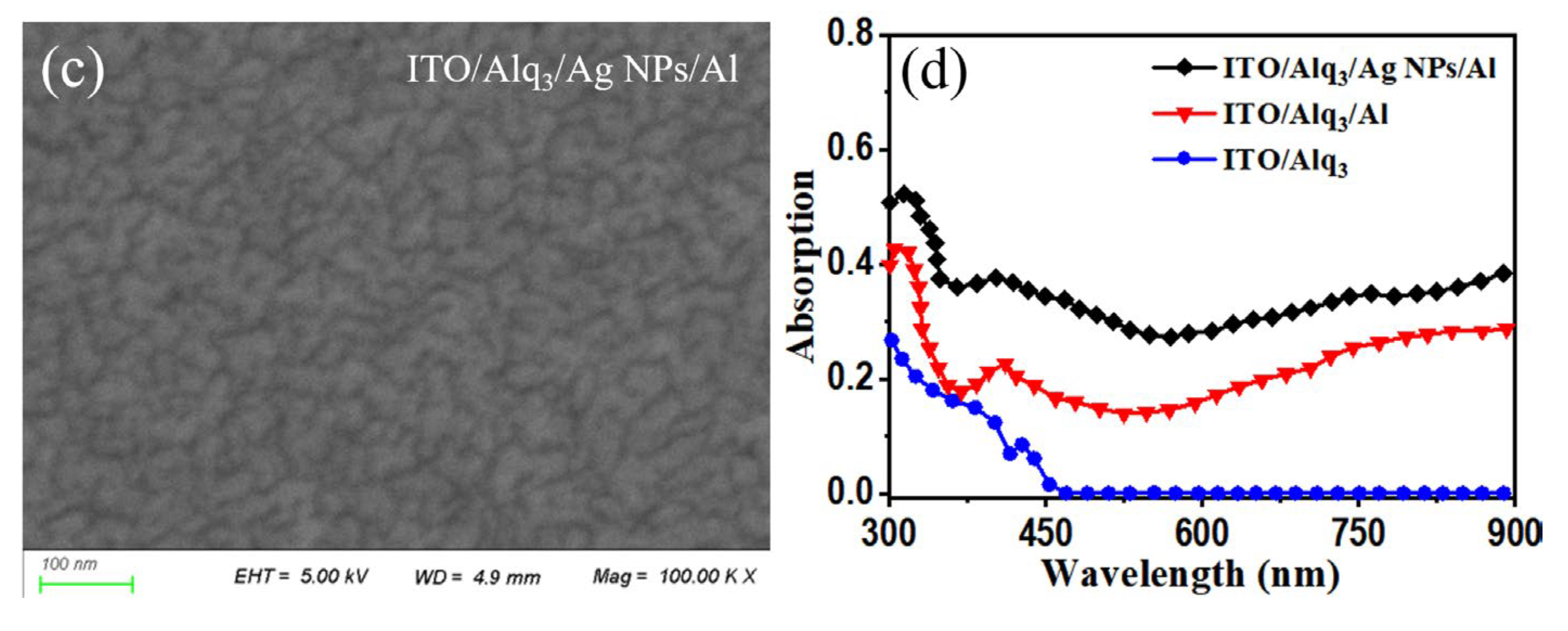

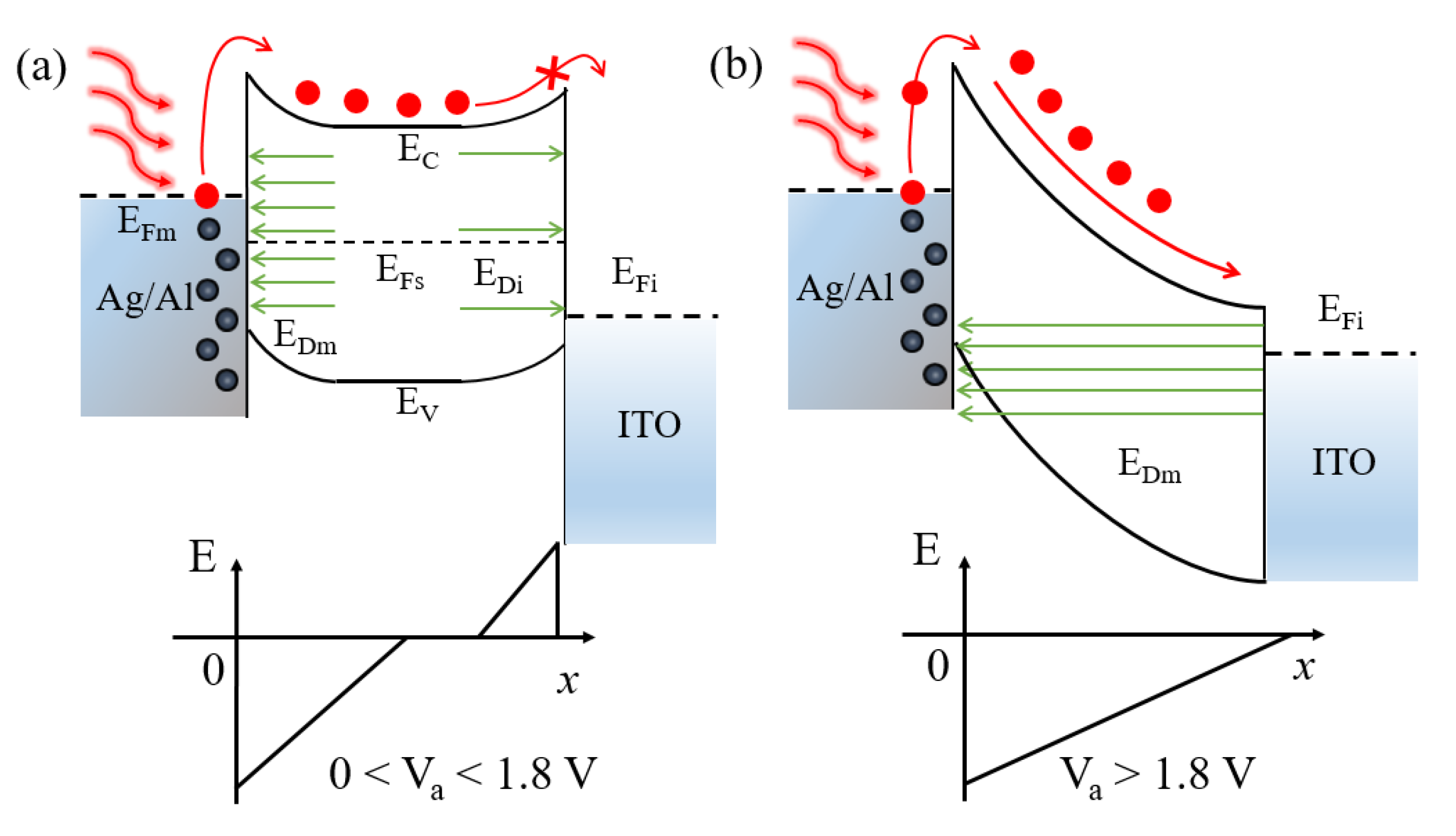
Publisher’s Note: MDPI stays neutral with regard to jurisdictional claims in published maps and institutional affiliations. |
© 2022 by the authors. Licensee MDPI, Basel, Switzerland. This article is an open access article distributed under the terms and conditions of the Creative Commons Attribution (CC BY) license (https://creativecommons.org/licenses/by/4.0/).
Share and Cite
Zhai, A.; Zhao, C.; Pan, D.; Zhu, S.; Wang, W.; Ji, T.; Li, G.; Wen, R.; Zhang, Y.; Hao, Y.; et al. Organic Photodetectors with Extended Spectral Response Range Assisted by Plasmonic Hot-Electron Injection. Nanomaterials 2022, 12, 3084. https://doi.org/10.3390/nano12173084
Zhai A, Zhao C, Pan D, Zhu S, Wang W, Ji T, Li G, Wen R, Zhang Y, Hao Y, et al. Organic Photodetectors with Extended Spectral Response Range Assisted by Plasmonic Hot-Electron Injection. Nanomaterials. 2022; 12(17):3084. https://doi.org/10.3390/nano12173084
Chicago/Turabian StyleZhai, Aiping, Chenjie Zhao, Deng Pan, Shilei Zhu, Wenyan Wang, Ting Ji, Guohui Li, Rong Wen, Ye Zhang, Yuying Hao, and et al. 2022. "Organic Photodetectors with Extended Spectral Response Range Assisted by Plasmonic Hot-Electron Injection" Nanomaterials 12, no. 17: 3084. https://doi.org/10.3390/nano12173084
APA StyleZhai, A., Zhao, C., Pan, D., Zhu, S., Wang, W., Ji, T., Li, G., Wen, R., Zhang, Y., Hao, Y., & Cui, Y. (2022). Organic Photodetectors with Extended Spectral Response Range Assisted by Plasmonic Hot-Electron Injection. Nanomaterials, 12(17), 3084. https://doi.org/10.3390/nano12173084






